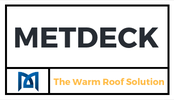Design & Installation
Our team of experts are on hand to help…
Design
At Metdeck, we have been involved in many landmark projects. Our early involvement ensures a roofing or cladding system is designed, specified and built not only to be visibly stunning but to last the lifetime of the building.
Roof Waterproofing
Metdeck is specifically designed for use with mechanically fixed metal roof finishes such as zinc & copper to the following standards:
- BS EN 5427: Part 1: 1996: Code of practice for the use of profiled sheet for roof and wall cladding on buildings
- BS EN 501: Roofing products from metal sheet
- BS EN 988: zinc and zinc alloys, specification for fully supported roofing products of zinc sheet for buildings
- CP 143: Part 5: 1964 zinc: Code of practice for sheet roof and wall coverings, specification for rolled flat products for buildings
Thermal Conductivity
The boards achieve a thermal conductivity (lambda value) of:
0.020 Wm/K for 45mm & above / 0.021 Wm/K for 25-44mm / 0.022 Wm/K for <25mm
Thermal Resistance
Thermal Resistance (R-value) varies with thickness and is calculated by dividing the thickness of the board (expressed in metres) by its thermal conductivity.

Cold Bridging
Reasonable provision must be made to limit the effects of cold bridging. The design should ensure that roof-light or ventilator kerbs etc. are always insulated to a similar standard as the general roof area. Where the roof design incorporates a parapet, 25mm thick insulation upstand of at least 150mm should be used around the perimeter of the roof on the internal facade of the parapet. The exposed face of the insulation must be lined with 18mm exterior grade plywood prior to the application of the waterproofing layer. Wall insulation should also be carried up into the parapet creating an overlap of insulation.
Water Vapour Control
A continuous bituminous self-sealing vapour barrier to BS EN 13970:2004 Flexible sheets for waterproofing – Bitumen water vapour control layers – Definitions and Characteristics must be applied on the roof deck prior to fitting Metdeck.
Sitework
Metdeck should be mechanically fixed, plywood uppermost, onto a continuously supporting substrate such as metal deck, plywood deck or concrete deck prepared with a bituminous vapour barrier (see Water Vapour Control). Number and type of fixings to be determined by the fixing manufacturer/supplier and should be designed taking into account wind loading (see Wind Loading).
Daily Working Practice
Metdeck is not designed as temporary waterproofing and should be protected as soon as possible after fixing. Due to the impermeable nature of metal waterproofing it is imperative that moisture is not trapped within the construction build-up. At the end of each days work or during extended periods of time a night joint should be formed to prevent water penetration of the construction.
Cutting
A fine toothed saw should be used to cut the boards. Metdeck must be butt close together to ensure continuity of insulation.
Packaging
Metdeck is supplied in labelled packs shrink wrapped in polythene.
Storage
The polythene packaging of Metdeck should not be considered adequate for long term outdoor protection. Ideally, Metdeck should be stored inside a building. If, however, outside storage cannot be avoided, then it should be stacked clear of the ground and covered with a polythene sheet or weatherproof tarpaulin. Metdeck that is wet should NOT be used.
